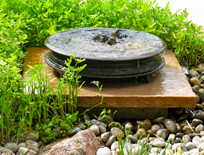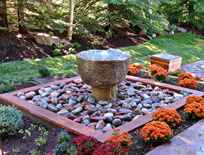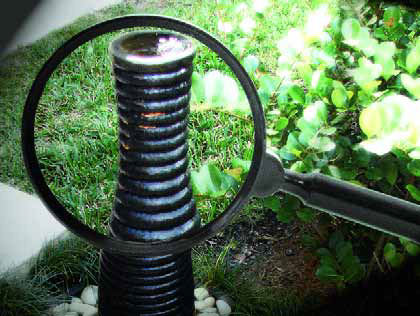Fountains
Decorative-concrete artist Tommy T. Cook has built a reputation for being able to create almost anything from concrete using an array of highly refined and boldly artful processes. In this feature, he demonstrates a portion of that skill by describing how he uses the gargantuan Gunnera plant to craft watershapes in which replicas of the plant’s outsized leaves serve as uniquely natural fountain basins and spillways. Ask anyone who’s tried and it’s almost certain you’ll hear that replicating nature isn’t easy. That hasn’t stopped artists throughout history from trying, however, or from making natural forms an influential source of artistic imagination and ambition. The great thing about using nature for inspiration is that it’s all around us and all we need to do to draw on it is open our eyes, make good choices and decide how what we see can be used in our creative endeavors. In my case, I’d worked in decorative concrete for a long time before nature crawled under my skin. It began when
The warmth and solid heft of aged, cast brass are the hallmarks of the antique rice cooker — a treasure acquired in India several years ago — that now makes a statement to visitors approaching a modern Colorado home's front door. Forged more than 150 years ago using the same techniques employed in making
Through the years, my experience in designing and building naturalistic and architectural watershapes has led me into several situations in which my clients have wanted to use a special heirloom or artifact of some kind as
For years, Montréal’s arts district has been the venue for music and theater performances, art exhibitions, festivals and all manner of cultural events. As part of a revitalization process in the area, notes David L’Heureux, the city recently unveiled the Place des Festivals and a spectacular watershape he and a distinguished design team built at its heart as a gathering place for residents and visitors of all ages and a civic focus for fun, relaxation and visual joy. Throughout North America in recent years, cities have turned to a variety of watershapes to enliven and, occasionally, revitalize their public spaces. These watershapes are more than the wonderful fountains long found in public parks and plazas. Indeed, the recent success of projects including Chicago’s Millennium Park and its ambitious combination of significant waterfeatures with gardens, architecture and art has demonstrated the tremendous potential that lies in crafting interesting, multi-functional places for people to gather. Canada offers a spectacular recent example of this trend in the form of
It was no easy task: We were called on to take the majestic landscape defined by the confluence of the Mississippi and Missouri rivers; use it as a template for an urban oasis filled with sculptures, plants and water; and develop a park that would mesh seamlessly with its surrounding urban spaces. Furthermore, they wanted this park to appeal to every conceivable user – people of all ages, needs and backgrounds – while also serving as a catalyst for growth and a profound revival of the city’s core. And not only was the space to carry that symbolic load, but it also had to function efficiently with long-term reliability. We at Hydro Dramatics (St. Louis, Mo.) know from experience that projects of this scope and scale require much planning and coordination to go along with large measures of innovation. We also know that these types of challenges make success that much sweeter. So we jumped into the task with all our energy, supporting the design team charged with developing Citygarden, a 2.9-acre parcel to be filled with
In recent centuries, watershapers have done a tremendous job of figuring out how water behaves in visual and aural terms and learned how to use those characteristics to make strong aesthetic impressions. Now that we’re entering an era in which environmental concerns are of increasing importance, however, we’re being challenged to think differently about water, how it affects us physically and the essential role it plays in maintaining a healthy world. That challenge is not insubstantial: As a species, we’ve done a great deal to squander water as an asset, whether by contaminating and otherwise polluting natural bodies of water or by treating pools and other watershapes with harsh chemicals. Isn’t it ironic that spas, which exist primarily so we can
Advances in fountain technology have defined a new class of animated watershapes that is not only more sophisticated but is also becoming more readily available. Here, Simon Gardiner of Crystal Fountains shares a pair of projects to illustrate how just two of these technologies – that is, submersible LED lighting and systems that make water dance – are helping his company and others bring fresh excitement to watershapes worldwide. The international fountain business is an exciting, highly competitive and ever-challenging field, basically because the clients are as distinctive as the projects they commission, the settings they provide and the countries they represent. At Crystal Fountains (Toronto), we’ve staked our reputation in the global marketplace on understanding those distinctions and built our competitive edge on keeping up with technological developments that help us animate spaces with water. The reason this constant forward progress in technology is so critical is that there’s a persistent, ongoing
One of the clearest trends I’ve seen in watershaping through the past few years involves the use of water in the front spaces of properties, usually along a driveway or close to the main entrance. It’s something I’ve noticed on both the residential and commercial sides of the business, and these projects really do seem to be gaining traction as more time passes. In some cases, they might be the only watershape you’ll find on site. In others, they introduce a presence of water to be echoed
Oregon watershaper Giorgos Eptaimeros has developed a reputation for providing his clients with the full range of exciting aquatic experiences. Always on the lookout for new options to offer and, more specifically, for ways to bring popular commercial- and waterpark-type features to his residential projects, he recently turned to a leaping-jet/splash-pad kit to bring a dynamic backyard play feature to a distinctly mid-range project. When I emigrated from Greece to the United States nearly 20 years ago, I already had more than a decade of commercial project management experience under my belt. As is the case with






















